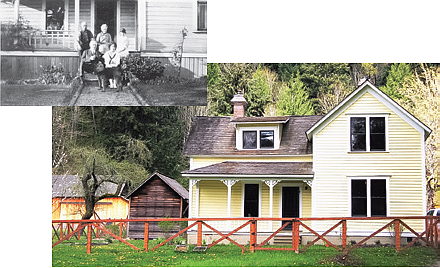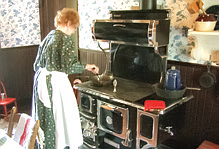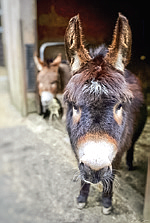Returning to the Farm
June 24, 2022 at 4:48 p.m. | Updated June 24, 2022 at 11:11 a.m.
It's time to return to the farm. The Mary Olson Farm in Auburn is open to the public once again! The following article was first published in 2017, and updated in 2022.
The chickens bring back memories of using a chopping gizmo as a child to cut up hard boiled eggs and feeding them to my grandmother’s banty chicks. My sister remarked that the stairs in the farmhouse reminded her of our uncle’s home, with its tall, somewhat narrow stairs. My other sister gasped with pleasure when she saw the attic bedrooms with their angled sloped ceilings and thick imperfect, lumpy but inviting-looking beds.
With 67 acres, seven fully restored historic farm structures, a 100+ year-old producing orchard, herb and flower beds, livestock, forested hillsides and large hay meadows, the Mary Olson Farm has everything it takes to conjure up childhood memories—whether they are real recollections or imagined scenes from reading Anne of Green Gables.
This spectacularly beautiful site is owned by the City of Auburn and functions as a special use park. During summer weekends, visitors are invited to stroll about, enjoy a picnic lunch under a tree in the orchard, tour the farmhouse or pet one of the livestock ambassadors. During the school year, several thousand school children tour the Farm on curricular-based field trips.
When Mary Olson was widowed, the farm remained in her name, even throughout her second marriage. She willed the Farm to her two unmarried children, Anna and Alfred. They lived out their lives on the Farm without electricity or plumbing into the early 1970s. The Farm fell into disrepair during the remaining twenty years, and was eventually purchased with grant funds by the city of Auburn. Twenty years more and about $2.3 million of grant-funded restoration, and VOILA! We have a perfectly rendered 1902 family subsistence farm.
During summer drop-in hours visitors can follow a path of interpretive signs that tell Mary’s story, explain the preservation and restoration efforts, list the antique variety fruit trees and answer guests’ most pressing questions, such as:
• Was that the real cook stove? No, it was missing when the city purchased the Farm, but it is a modern replica which meets current standards and is used for baking biscuits during Living History Summer Camp.
• Is the furniture original? Some of it is! The woman who managed Alfred Olson’s estate kept a lot of the furniture, and her daughter generously donated much of it back.
• Why do you have miniature donkeys? Because their job is to greet first graders and be livestock ambassadors. They are little, friendly – much like dogs – and beloved by all!
• Are there fish in that stream? YES! We are proud to say that after twenty years of restoration efforts, Olson Stream boasts fall runs of Chinook, Chum, Coho and Pink.
For those pondering a visit, know that the Farm has been developed to be as accessible as an old farm can be. There are packed, mostly level gravel pathways and very subtle ramps leading into the key buildings—so most people will find it navigable. Parking is more of an access challenge, with the lot located over a hill with a 1/8 mile up and down trail through the forest to traverse. Visitors with mobility issues can be dropped off at the front gate if prior arrangements are made. Park entry is free, with a suggested donation of $2 for seniors and children and $5 for adults. The Mary Olson Farm is open Saturdays and Sundays, June 24 through August 27, noon to 5pm. Wear your walking shoes and prepare to retrieve some childhood memories!
MORE INFORMATION
• A City of Auburn park, Mary Olson Farm is located at 28728 Green River Road SE. It is open Saturdays and Sundays, June 18 through August 14, 11am to 4pm. The Farm also hosts special events, like the annual Hops & Crops Music & Beer Festival – the 2022 festival takes place on September 17 from noon to 6pm (21 and up only).
• Looking for an interesting place to volunteer? Volunteer hosts greet visitors, help open and close the farm and answer questions. Fall Fieldtrip Tour Guides work with groups of students.
• For information about the delightful Mary Olson Farm, call 253- 288-7437 or visit www.wrvmuseum.org.
It's time to return to the farm. The Mary Olson Farm in Auburn is open to the public once again! The following article was first published in 2017, and updated in 2022.
The chickens bring back memories of using a chopping gizmo as a child to cut up hard boiled eggs and feeding them to my grandmother’s banty chicks. My sister remarked that the stairs in the farmhouse reminded her of our uncle’s home, with its tall, somewhat narrow stairs. My other sister gasped with pleasure when she saw the attic bedrooms with their angled sloped ceilings and thick imperfect, lumpy but inviting-looking beds.
With 67 acres, seven fully restored historic farm structures, a 100+ year-old producing orchard, herb and flower beds, livestock, forested hillsides and large hay meadows, the Mary Olson Farm has everything it takes to conjure up childhood memories—whether they are real recollections or imagined scenes from reading Anne of Green Gables.
This spectacularly beautiful site is owned by the City of Auburn and functions as a special use park. During summer weekends, visitors are invited to stroll about, enjoy a picnic lunch under a tree in the orchard, tour the farmhouse or pet one of the livestock ambassadors. During the school year, several thousand school children tour the Farm on curricular-based field trips.
When Mary Olson was widowed, the farm remained in her name, even throughout her second marriage. She willed the Farm to her two unmarried children, Anna and Alfred. They lived out their lives on the Farm without electricity or plumbing into the early 1970s. The Farm fell into disrepair during the remaining twenty years, and was eventually purchased with grant funds by the city of Auburn. Twenty years more and about $2.3 million of grant-funded restoration, and VOILA! We have a perfectly rendered 1902 family subsistence farm.
During summer drop-in hours visitors can follow a path of interpretive signs that tell Mary’s story, explain the preservation and restoration efforts, list the antique variety fruit trees and answer guests’ most pressing questions, such as:
• Was that the real cook stove? No, it was missing when the city purchased the Farm, but it is a modern replica which meets current standards and is used for baking biscuits during Living History Summer Camp.
• Is the furniture original? Some of it is! The woman who managed Alfred Olson’s estate kept a lot of the furniture, and her daughter generously donated much of it back.
It's time to return to the farm. The Mary Olson Farm in Auburn is open to the public once again! The following article was first published in 2017, and updated in 2022.
The chickens bring back memories of using a chopping gizmo as a child to cut up hard boiled eggs and feeding them to my grandmother’s banty chicks. My sister remarked that the stairs in the farmhouse reminded her of our uncle’s home, with its tall, somewhat narrow stairs. My other sister gasped with pleasure when she saw the attic bedrooms with their angled sloped ceilings and thick imperfect, lumpy but inviting-looking beds.
With 67 acres, seven fully restored historic farm structures, a 100+ year-old producing orchard, herb and flower beds, livestock, forested hillsides and large hay meadows, the Mary Olson Farm has everything it takes to conjure up childhood memories—whether they are real recollections or imagined scenes from reading Anne of Green Gables.
This spectacularly beautiful site is owned by the City of Auburn and functions as a special use park. During summer weekends, visitors are invited to stroll about, enjoy a picnic lunch under a tree in the orchard, tour the farmhouse or pet one of the livestock ambassadors. During the school year, several thousand school children tour the Farm on curricular-based field trips.
When Mary Olson was widowed, the farm remained in her name, even throughout her second marriage. She willed the Farm to her two unmarried children, Anna and Alfred. They lived out their lives on the Farm without electricity or plumbing into the early 1970s. The Farm fell into disrepair during the remaining twenty years, and was eventually purchased with grant funds by the city of Auburn. Twenty years more and about $2.3 million of grant-funded restoration, and VOILA! We have a perfectly rendered 1902 family subsistence farm.
During summer drop-in hours visitors can follow a path of interpretive signs that tell Mary’s story, explain the preservation and restoration efforts, list the antique variety fruit trees and answer guests’ most pressing questions, such as:
It's time to return to the farm. The Mary Olson Farm in Auburn is open to the public once again! The following article was first published in 2017, and updated in 2022.
The chickens bring back memories of using a chopping gizmo as a child to cut up hard boiled eggs and feeding them to my grandmother’s banty chicks. My sister remarked that the stairs in the farmhouse reminded her of our uncle’s home, with its tall, somewhat narrow stairs. My other sister gasped with pleasure when she saw the attic bedrooms with their angled sloped ceilings and thick imperfect, lumpy but inviting-looking beds.
With 67 acres, seven fully restored historic farm structures, a 100+ year-old producing orchard, herb and flower beds, livestock, forested hillsides and large hay meadows, the Mary Olson Farm has everything it takes to conjure up childhood memories—whether they are real recollections or imagined scenes from reading Anne of Green Gables.









